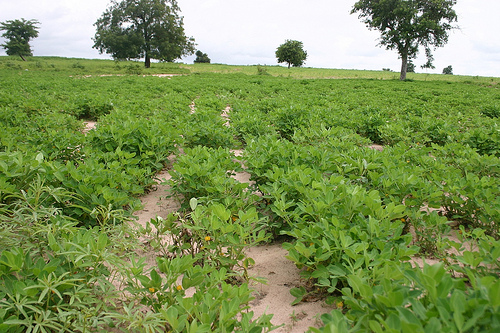
Adaptation
 While some plants, like
tomatoes, prefer to grow in a richly garden soil, legumes
are able to grow in relatively average to poor quality soil. The
ideal pH of soil for peanut growth is between 6.0 and 6.5, which
is slightly acidic. Peanuts tend to grow well in stiff soil with
a clay-like property. However, this kind of soil dyes the pods a
darker color, which, for aesthetic reasons, is undesirable in
the peanut market. Thus, they are more often grown in light,
sandy, porous soil. That isn't to say they don't grow well, in
the lighter soil; simply that the crop yield isn't quite as
high. As far as fertilization goes, since the peanut is pretty
hardy, it can grow in the same fertilizer that is used for
corn, cowpeas, or cotton. The only requirement the peanut
plant has is that there
is plenty of lime in the soil.
While some plants, like
tomatoes, prefer to grow in a richly garden soil, legumes
are able to grow in relatively average to poor quality soil. The
ideal pH of soil for peanut growth is between 6.0 and 6.5, which
is slightly acidic. Peanuts tend to grow well in stiff soil with
a clay-like property. However, this kind of soil dyes the pods a
darker color, which, for aesthetic reasons, is undesirable in
the peanut market. Thus, they are more often grown in light,
sandy, porous soil. That isn't to say they don't grow well, in
the lighter soil; simply that the crop yield isn't quite as
high. As far as fertilization goes, since the peanut is pretty
hardy, it can grow in the same fertilizer that is used for
corn, cowpeas, or cotton. The only requirement the peanut
plant has is that there
is plenty of lime in the soil.
The peanut is also quite flexible in regards to how much water it receives. Once the plant itself is firmly established, it is both drought resistant and, to an extent, tolerant of flooding. The ideal amount of water for commercial peanut production is roughly between 500 and 1000 mm. However, if the environment lacks precipitation, then it can also survive and produce a crop in 300 - 400 mm of water.
As the flowers of the peanut plant mature, they tend to droop towards the ground. This is an adaptation that allows them easier access to the ground when driving their pegs in. For more information on this flower phenomenon, please see the reproduction page.
 Peanuts, like all legumes, have a symbiotic relationship with
a rhizobial bacteria to change atmospheric nitrogen (N2) into a more
useable form, such as ammonia (NH3). It proves beneficial to
the farmer to plant the peanut in the same field before or around
the same time as another plant because of these bacteria. If the
nitrogen fixing peanut plant is in the field first, then it is able
to enrich the soil with useable nitrogen, thus decreasing or
altogether eliminating the need for adding nitrogen to the
fertilizer. For more information about the peanut's relationship the
the rhizobial bacteria, please visit the
interactions page.
Peanuts, like all legumes, have a symbiotic relationship with
a rhizobial bacteria to change atmospheric nitrogen (N2) into a more
useable form, such as ammonia (NH3). It proves beneficial to
the farmer to plant the peanut in the same field before or around
the same time as another plant because of these bacteria. If the
nitrogen fixing peanut plant is in the field first, then it is able
to enrich the soil with useable nitrogen, thus decreasing or
altogether eliminating the need for adding nitrogen to the
fertilizer. For more information about the peanut's relationship the
the rhizobial bacteria, please visit the
interactions page.